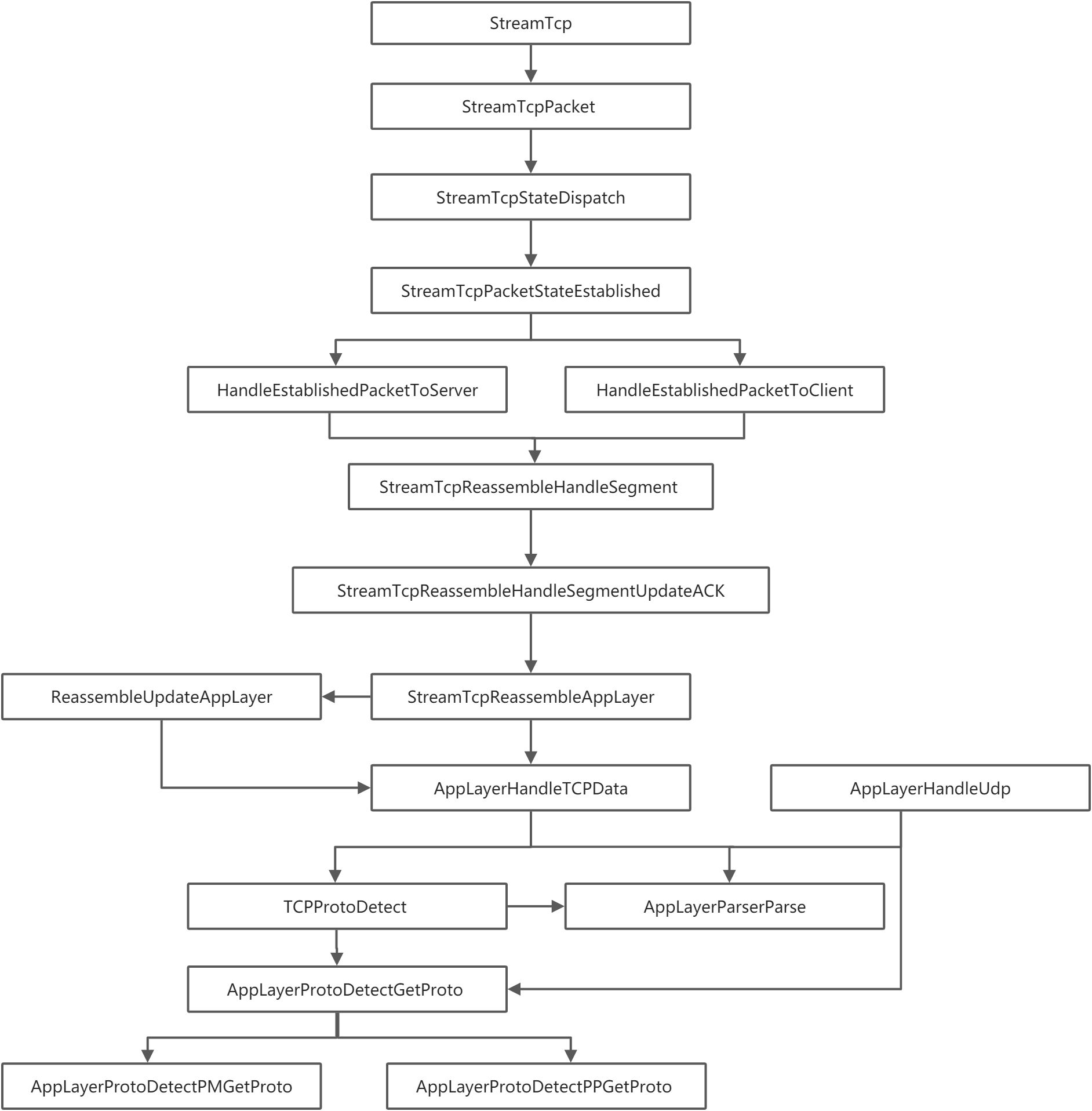Suricata源码分析-协议解析模块
注:以下分析基于了解flow engine的前提,请先阅读上篇《流管理引擎flow engine》
配置初始化
协议解析模块配置信息的初始化,和flow engine的初始化在同一层的函数调用中,即SuricataMain* -> PostConfLoadedSetup*(包含一些配置被加载后需要运行的代码) -> PreRunInit*(主模式和unix-socket模式的初始化代码) ->* StreamTcpInitConfig*(初始化stream全局配置数据)*
StreamTcpInitConfig
该函数会首先填充全局配置结构stream_config,结构体类型为TcpStreamCnf
typedef struct TcpStreamCnf_ {
/** stream tracking
*
* max stream mem usage
*/
// stream跟踪功能所能使用的最大内存,默认为32MB
SC_ATOMIC_DECLARE(uint64_t, memcap);
// 流重组的最大内存用量,默认为64MB
SC_ATOMIC_DECLARE(uint64_t, reassembly_memcap);
// 新的流标志将被初始化到这里
uint16_t stream_init_flags;
/* coccinelle: TcpStreamCnf:flags:STREAMTCP_INIT_ */
uint8_t flags;
// 能存放在队列中的SYN/ACK的最大数量,默认为5
uint8_t max_synack_queued;
// 为每个stream线程预分配的session数量
uint32_t prealloc_sessions;
// 为每个stream线程预分配的segment数量
uint32_t prealloc_segments;
// 是否允许接手midstream session,默认为关闭
int midstream;
// 是否打开异步stream处理,默认为关闭
int async_oneside;
// 重组流的深度,默认为1MB
uint32_t reassembly_depth;
uint16_t reassembly_toserver_chunk_size;
uint16_t reassembly_toclient_chunk_size;
bool streaming_log_api;
StreamingBufferConfig sbcnf;
} TcpStreamCnf;
除此之外,还有以下功能:
- 调用 StreamTcpReassembleInit 对重组功能进行初始化
- 调用 FlowSetProtoFreeFunc,设置flow engine对TCP的自定义状态处理函数和清理函数
模块初始化
stream模块的初始化,在flow worker线程的初始化函数中:FlowWorkerThreadInit -> StreamTcpThreadInit,函数流程为:
-
创建一个
StreamTcpThread类型结构体stt作为该模块的在本线程的context。 -
设置
stt->ssn_pool_id为-1。 -
注册一些性能计数器,例如TCP会话数、无效checksum包数、syn包数、synack包数、rst包数等。
-
调用 StreamTcpReassembleInitThreadCtx 初始化重组的context,保存在
stt->ra_ctx。 -
若
ssn_pool为NULL,则调用 PoolThreadExpand 为它创建一个新的PoolThread,预分配大小即为stream_config.prealloc_sessions,而创建的对象为TcpSession。 -
若不为NULL,则调用 PoolThreadExpand 扩充原有的
ssn_pool。
注:Pool是一个suricata中实现的通用的池存储,可以避免不断malloc和free的开销,并且显著减少堆碎片。PoolThread只是在Pool上做了一层包装,允许多个同类线程共用一个Pool数组,每个线程对应其中一项
模块入口及核心代码
协议解析的入口也在 FlowWorker 函数中,调用堆栈:FlowWorker -> FlowWorkerStreamTCPUpdate -> StreamTcp,在执行完流查找和流更新之后,就开始进行协议解析。而在协议解析之后,则会进行规则检测和信息的输出。截取部分代码:
// 处理TCP和应用层协议
if (p->flow && PKT_IS_TCP(p)) {
SCLogDebug("packet %"PRIu64" is TCP. Direction %s", p->pcap_cnt, PKT_IS_TOSERVER(p) ? "TOSERVER" : "TOCLIENT");
DEBUG_ASSERT_FLOW_LOCKED(p->flow);
// 如果检测被禁用,我们需要在第一个数据包上对流设置文件标志
if (detect_thread == NULL &&
((PKT_IS_TOSERVER(p) && (p->flowflags & FLOW_PKT_TOSERVER_FIRST)) ||
(PKT_IS_TOCLIENT(p) && (p->flowflags & FLOW_PKT_TOCLIENT_FIRST))))
{
DisableDetectFlowFileFlags(p->flow);
}
FlowWorkerStreamTCPUpdate(tv, fw, p, detect_thread);
FlowWorkerStreamTCPUpdate
代码及注释如下:
static inline void FlowWorkerStreamTCPUpdate(ThreadVars *tv, FlowWorkerThreadData *fw,
Packet *p, void *detect_thread)
{
FLOWWORKER_PROFILING_START(p, PROFILE_FLOWWORKER_STREAM);
StreamTcp(tv, p, fw->stream_thread, &fw->pq);
FLOWWORKER_PROFILING_END(p, PROFILE_FLOWWORKER_STREAM);
// 检查是否为流设置了改变proto的标志
if (FlowChangeProto(p->flow)) {
// 在两个方向上创建数据包,以便在切换协议前刷新记录和检测
StreamTcpDetectLogFlush(tv, fw->stream_thread, p->flow, p, &fw->pq);
AppLayerParserStateSetFlag(p->flow->alparser, APP_LAYER_PARSER_EOF_TS);
AppLayerParserStateSetFlag(p->flow->alparser, APP_LAYER_PARSER_EOF_TC);
}
// 这里的数据包可以安全地访问p->flow,因为它被锁定了
SCLogDebug("packet %"PRIu64": extra packets %u", p->pcap_cnt, fw->pq.len);
Packet *x;
// 如果数据包队列没有上锁,取出数据包
while ((x = PacketDequeueNoLock(&fw->pq))) {
SCLogDebug("packet %"PRIu64" extra packet %p", p->pcap_cnt, x);
// 规则检测
if (detect_thread != NULL) {
FLOWWORKER_PROFILING_START(x, PROFILE_FLOWWORKER_DETECT);
Detect(tv, x, detect_thread);
FLOWWORKER_PROFILING_END(x, PROFILE_FLOWWORKER_DETECT);
}
// 输出模块
OutputLoggerLog(tv, x, fw->output_thread);
// 把这些数据包放在preq队列中,以便它们在数据包'p'之前被其他线程模块接受。
PacketEnqueueNoLock(&tv->decode_pq, x);
}
}
StreamTcp -> StreamTcpPacket
StreamTcp 实现流重组、协议识别和报文结构解析,实际工作主要由 StreamTcpPacket 完成
-
首先调用进行重组(这里不深入分析tcp重组的部分)
-
重组完成后,调用 AppLayerHandleTCPData 进行应用层处理
-
- 调用 TCPProtoDetect 进行协议识别
- 调用 AppLayerParserParse 进行协议解析(比如http解析锚点、html头部等)
附:流分析的两个特点
- 流分析并不是分析包的信息,而是分析相反方向上流的信息。举个例子,收到了一个客户端发送到服务器端的报文,那么分析的数据是服务器端对客户端发送数据的缓存内容,因为收到了客户端的报文,说明反方向上的数据接收完毕了,可以进行分析。
- 先进行协议的检测,通过识别到协议,然后调用该协议注册的解析函数进行相关的解析工作,协议识别的调用过程如下:
协议解析核心代码
整体流程概述
函数调用堆栈: -> StreamTcpPacket -> StreamTcpStateDispatch(处理每一个session的state逻辑) -> StreamTcpPacketStateEstablished*(处理Established状态的函数) ->* HandleEstablishedPacketToServer*/HandleEstablishedPacketToClient*(分别处理两个方向Established状态的报文) -> StreamTcpReassembleHandleSegment* -> StreamTcpReassembleHandleSegmentUpdateACK*(基于接收到的ACK报文更新应用层) -> StreamTcpReassembleAppLayer*(收到数据包之后更新流重组) ->* AppLayerHandleTCPData*(处理应用层TCP数据)*
在 StreamTcpReassembleAppLayer 函数中通过其他的函数,最终也会调用到 AppLayerHandleTCPData
注:FlowWorker中会判断tcp或udp调用不同的函数,tcp会按照上述层级调用 AppLayerHandleTCPData,udp则会调用 AppLayerHandleUdp(如dns协议、http协议),但最终都会调用 AppLayerParserParse 来进行协议的解析。

协议识别
解析需要先进行协议的识别,判断出流的协议后,在结构体中设置标志,给后面的解析函数使用,协议识别主要分为三种方式。函数调用堆栈:*AppLayerHandleTCPData* -> *TCPProtoDetect* (协议类型检测)-> *AppLayerProtoDetectGetProto* ->
-
*AppLayerProtoDetectPMGetProto*:通过特征串匹配
-
*AppLayerProtoDetectPPGetProto* :通过探测方式识别,主动发送报文探测结果
-
*AppLayerProtoDetectPEGetProto*
应用层协议保存在全局变量alp_ctx中,存放了协议识别使用的各种数据,如:字符串、状态模式等,类型为AppLayerParserProtoCtx,是一个二维数组,横坐标是流协议的映射,纵坐标是应用层协议。
typedef struct AppLayerParserCtx_ {
AppLayerParserProtoCtx ctxs[FLOW_PROTO_MAX][ALPROTO_MAX];
} AppLayerParserCtx;
// 应用层协议解析器内容
typedef struct AppLayerParserProtoCtx_
{
/* 0 - to_server, 1 - to_client. */
AppLayerParserFPtr Parser[2]; // 指向协议解析函数
...
} AppLayerParserProtoCtx;
具体结构详见 app-layer-parser.c line96
// 协议检索
AppProto AppLayerProtoDetectGetProto(AppLayerProtoDetectThreadCtx *tctx, Flow *f,
const uint8_t *buf, uint32_t buflen, uint8_t ipproto, uint8_t flags, bool *reverse_flow)
{
SCEnter();
SCLogDebug("buflen %u for %s direction", buflen,
(flags & STREAM_TOSERVER) ? "toserver" : "toclient");
// 定义返回值
AppProto alproto = ALPROTO_UNKNOWN;
// 记录PM模式获取的协议号
AppProto pm_alproto = ALPROTO_UNKNOWN;
if (!FLOW_IS_PM_DONE(f, flags)) {
AppProto pm_results[ALPROTO_MAX];
// 通过特征串模式匹配协议
uint16_t pm_matches = AppLayerProtoDetectPMGetProto(
tctx, f, buf, buflen, flags, pm_results, reverse_flow);
if (pm_matches > 0) {
// 获取检测结果
alproto = pm_results[0];
// 重新运行其他方向的协议解析器,如果未知
uint8_t reverse_dir = (flags & STREAM_TOSERVER) ? STREAM_TOCLIENT : STREAM_TOSERVER;
if (FLOW_IS_PP_DONE(f, reverse_dir)) {
AppProto rev_alproto = (flags & STREAM_TOSERVER) ? f->alproto_tc : f->alproto_ts;
if (rev_alproto == ALPROTO_UNKNOWN) {
FLOW_RESET_PP_DONE(f, reverse_dir);
}
}
// HACK:如果检测到的协议是dcerpc/udp,我们也运行PP模式,
// 以避免误将DNS检测为dcerpc。
if (!(ipproto == IPPROTO_UDP && alproto == ALPROTO_DCERPC))
goto end;
// 为PM模式协议号赋值
pm_alproto = alproto;
/* fall through */
// 失败
}
}
if (!FLOW_IS_PP_DONE(f, flags)) {
bool rflow = false;
// 尝试为这个流调用探测解析器
alproto = AppLayerProtoDetectPPGetProto(f, buf, buflen, ipproto, flags, &rflow);
// 如果alproto协议号有效
if (AppProtoIsValid(alproto)) {
if (rflow) {
*reverse_flow = true;
}
goto end;
}
}
// 查看期望列表中是否有流被发现
if (!FLOW_IS_PE_DONE(f, flags)) {
// 调用probing expectation
alproto = AppLayerProtoDetectPEGetProto(f, ipproto, flags);
}
end:
// 如果alproto协议号无效,将pm_alproto赋值给他并返回
if (!AppProtoIsValid(alproto))
alproto = pm_alproto;
SCReturnUInt(alproto);
}
特征串方式
协议识别初始化-注册特征串
特征串和探测两种方式的初始化都是由 PostConfLoadedSetup(见上文配置初始化部分) 中的 AppLayerSetup 函数实现,其中调用的函数为:
// 初始化单模多模算法等
AppLayerProtoDetectSetup();
AppLayerParserSetup();
// 注册应用层协议解析器
AppLayerParserRegisterProtocolParsers();
// 添加特征到状态模式并编译
AppLayerProtoDetectPrepareState();
AppLayerSetupCounters();
这里需要展开讲一下 AppLayerParserRegisterProtocolParsers,这个函数为每个协议注册字符串,会调用各协议的 Register*Parsers 函数。而这些注册函数会通过调用 AppLayerProtoDetectPMRegisterPatternCI 或 AppLayerProtoDetectPMRegisterPatternCS 来注册字符串,它们最终都会调用到 AppLayerProtoDetectPMAddSignature 将其转换为签名并添加到线程ctx中。
举个栗子:RegisterHTPParsers -> HTPRegisterPatternsForProtocolDetection -> AppLayerProtoDetectPMRegisterPatternCI -> AppLayerProtoDetectPMRegisterPattern -> AppLayerProtoDetectPMAddSignature
识别过程:AppLayerProtoDetectPMGetProto
- 核心匹配函数 PMGetProtoInspect,该函数会调用注册好的多模搜索函数(注①),进行关键字符串的查找,并将匹配的结果返回。
- 根据搜索函数返回的结果,调用 AppLayerProtoDetectPMMatchSignature 提取出协议号。
注①:suricata中初始化函数PostConfLoadedSetup 中调用 MpmTableSetup 注册了多模式匹配表(多模匹配算法有两种,默认是Aho-Corasick算法,另一种是Hyperscan),单模匹配表的注册由 SpmTableSetup 完成(单模算法为Boyer-Moore算法和Hyperscan算法)
探测方式
协议识别初始化
- 探测方式的识别以DNP3为例,RegisterDNP3Parsers 函数中调用 AppLayerProtoDetectPPParseConfPorts 注册了 DNP3ProbingParser 的探测函数:
if (!AppLayerProtoDetectPPParseConfPorts("tcp", IPPROTO_TCP,
proto_name, ALPROTO_DNP3, 0, sizeof(DNP3LinkHeader),
DNP3ProbingParser, DNP3ProbingParser)) {
return;
}
函数内部执行流程:AppLayerProtoDetectPPParseConfPorts -> AppLayerProtoDetectPPRegister -> AppLayerProtoDetectInsertNewProbingParser -> AppLayerProtoDetectProbingParserElementDuplicate
- AppLayerParserRegisterParser 注册应用层协议函数,给
Parser赋值协议处理函数
AppLayerParserRegisterParser(IPPROTO_TCP, ALPROTO_DNP3, STREAM_TOSERVER,
DNP3ParseRequest);
AppLayerParserRegisterParser(IPPROTO_TCP, ALPROTO_DNP3, STREAM_TOCLIENT,
DNP3ParseResponse);
int AppLayerParserRegisterParser(uint8_t ipproto, AppProto alproto,
uint8_t direction,
AppLayerParserFPtr Parser)
{
SCEnter();
alp_ctx.ctxs[FlowGetProtoMapping(ipproto)][alproto].
Parser[(direction & STREAM_TOSERVER) ? 0 : 1] = Parser;
SCReturnInt(0);
}
*识别过程:AppLayerProtoDetectPPGetProto*
-
获取四层协议
-
获取端口信息
-
获取协议、端口解析函数
-
调用解析函数来解析,获取协议类型。
AppProto alproto = ALPROTO_UNKNOWN;
if (flags & STREAM_TOSERVER && pe->ProbingParserTs != NULL) {
alproto = pe->ProbingParserTs(f, flags, buf, buflen, rdir);
} else if (flags & STREAM_TOCLIENT && pe->ProbingParserTc != NULL) {
alproto = pe->ProbingParserTc(f, flags, buf, buflen, rdir);
}
协议解析
(具体会在下篇smtp协议解析模块介绍,此处只介绍流程)所有应用层协议解析模块的初始化也是在 AppLayerSetup -> AppLayerParserRegisterProtocolParsers 函数中完成。之后经过上面协议识别,确定了协议类型后,则会调用 AppLayerParserParse 函数进行具体的解析工作。
- 获取到结构体指针p
AppLayerParserProtoCtx *p = &alp_ctx.ctxs[f->protomap][alproto];
- 调用各协议注册的解析函数
// 调用递归分析器,但只针对数据。我们可能会在EOF时得到空的msgs
if (input_len > 0 || (flags & STREAM_EOF)) {
// 调用解析器
AppLayerResult res = p->Parser[direction](f, alstate, pstate,
input, input_len,
alp_tctx->alproto_local_storage[f->protomap][alproto],
flags);
if (res.status < 0) {
goto error;
} else if (res.status > 0) {
DEBUG_VALIDATE_BUG_ON(res.consumed > input_len);
DEBUG_VALIDATE_BUG_ON(res.needed + res.consumed < input_len);
DEBUG_VALIDATE_BUG_ON(res.needed == 0);
// 不完整只支持TCP
DEBUG_VALIDATE_BUG_ON(f->proto != IPPROTO_TCP);
// 在不当使用返回代码时,将协议置于错误状态。
if (res.consumed > input_len || res.needed + res.consumed < input_len) {
goto error;
}
if (f->proto == IPPROTO_TCP && f->protoctx != NULL) {
TcpSession *ssn = f->protoctx;
SCLogDebug("direction %d/%s", direction,
(flags & STREAM_TOSERVER) ? "toserver" : "toclient");
if (direction == 0) {
/* 解析器告诉我们在它所消耗的数据之上还需要多少数据。所以我们需要在
* 下次调用之前告诉流引擎我们需要多少数据
*/
ssn->client.data_required = res.needed;
SCLogDebug("setting data_required %u", ssn->client.data_required);
调用的函数类似于:
static int IEC104ParseRequest(Flow *f, void *state, AppLayerParserState *pstate, uint8_t *input, uint32_t input_len,
void *local_data)






 浙公网安备 33010602011771号
浙公网安备 33010602011771号